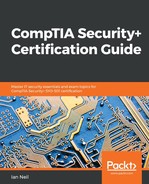In the past, when companies wanted meetings, such as a sales meeting, a date was set and the salespeople kept their schedule open, travelling to the location of the meeting the night before and booked themselves into a hotel. This was very costly and time-consuming; nowadays we use videoconferencing where everyone connects to the meeting, does not have to travel, and can free their schedule, making them more productive. In the Security+ exam, we need to be able to understand which protocols are used. There are three main protocols and these are:
- Session Initiated Protocol (SIP): Allows people from all over the internet, and those with VoIP, to communicate using their computers, tablets, and smartphones. An example would be of a secretary who could receive a Skype call for the boss: SIP allows them to put the caller on hold, speak to their boss, and, if needs be, put the person through.
- Real Time Protocol (RTP): Once SIP has established the session, RTP transfers the videoconferencing traffic.
- Secure Real Time Protocol (SRTP): Used to secure the videoconferencing traffic, it normally uses TCP port 5061.
- VLAN: Voice traffic being placed in a VLAN segments it from the rest of the network.
- Media gateway: Allows different methods of video and voice to communicate with each other: for example, if you use an XMPP gateway, you can connect Jabber clients to a Skype session.
Exam tip:
Voice traffic should be placed in its own VLAN to ensure reliability.
Voice traffic should be placed in its own VLAN to ensure reliability.
